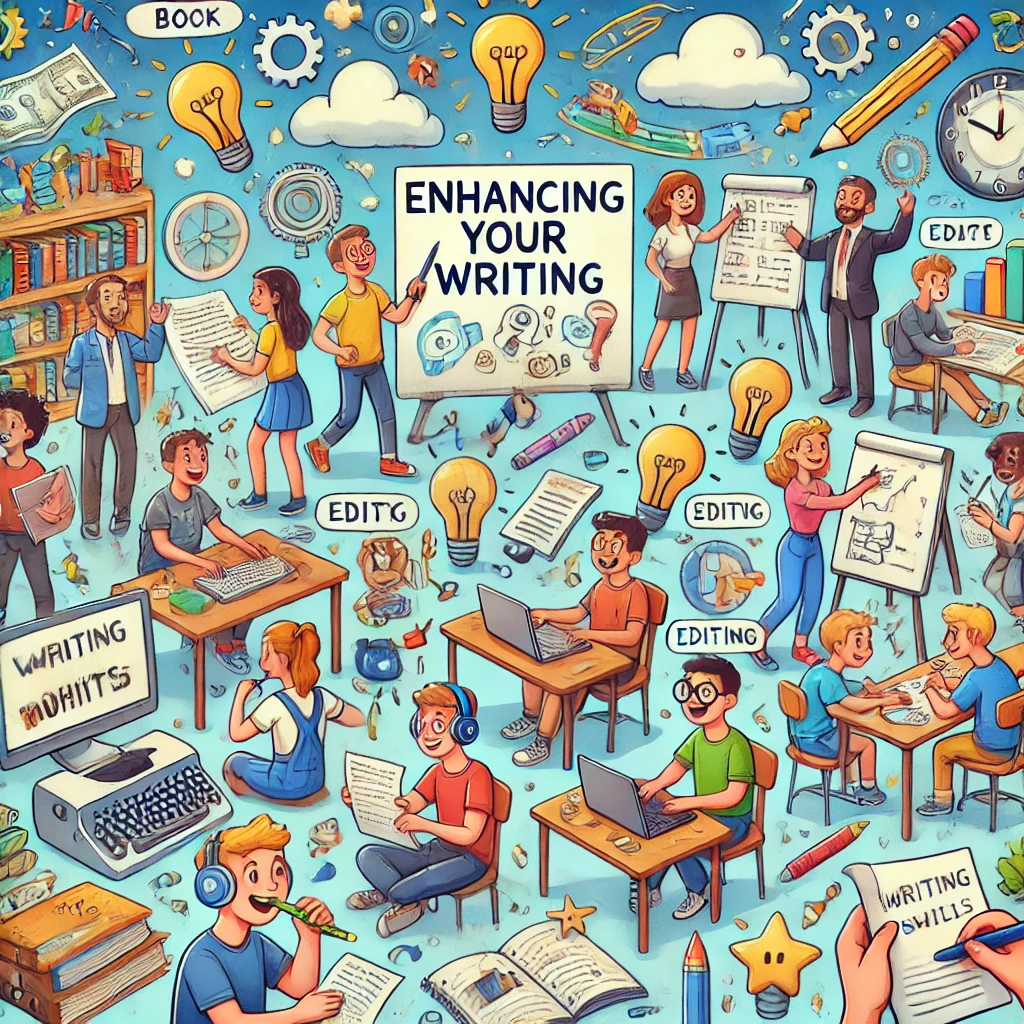Descriptive, Persuasive, and Narrative Writing

Descriptive Writing: Use Descriptive Language to Create Vivid Images
Definition:
- Descriptive writing involves using detailed observations and sensory language to create vivid images in the reader’s mind. It aims to paint a picture with words, making the scene, character, or object come alive.
Key Techniques
Sensory Details:
Incorporate details related to the five senses (sight, sound, smell, taste, touch) to make your descriptions more immersive.
Figurative Language:
Use similes, metaphors, and personification to add depth and creativity to your descriptions.
Specificity:
Use specific and precise language to describe objects, people, and scenes accurately.
Show, Don’t Tell:
Instead of simply stating facts, show the reader through detailed descriptions and actions.
Examples
Sight: “The sunset painted the sky with hues of orange, pink, and purple, casting a golden glow over the tranquil lake.”
Sound: “The leaves rustled in the wind, whispering secrets to one another as the branches swayed gently.”
Smell: “The aroma of freshly baked bread wafted through the air, filling the kitchen with a warm, comforting scent.”
Taste: “The chocolate cake melted in my mouth, its rich, velvety texture a perfect blend of sweetness and decadence.”
Touch: “The cat’s fur was soft and silky under my fingers, its warmth a soothing presence on my lap.”
Applications
Creative Writing: Enhances short stories, poems, and novels by creating vivid scenes and characters.
Travel Writing: Brings locations to life, making readers feel as if they are experiencing the place themselves.
Personal Narratives: Adds depth and emotion to personal stories by vividly describing experiences and emotions.
Persuasive Writing: Learn Techniques to Persuade and Convince Readers
Definition:
- Persuasive writing aims to convince the reader to accept a particular point of view or take a specific action. It involves presenting arguments, reasoning, and evidence to support your position.
Key Techniques
Clear Position:
State your position clearly and confidently from the beginning.
Logical Arguments:
Use logical reasoning and evidence to support your arguments. Present facts, statistics, and expert opinions.
Emotional Appeal:
Connect with the reader’s emotions by using anecdotes, personal stories, and vivid language that evokes feelings.
Counterarguments:
Address potential counterarguments and refute them with solid evidence and reasoning.
Call to Action:
End with a strong call to action, encouraging the reader to take a specific step or change their viewpoint.
Examples
Position Statement: “Climate change is the most pressing issue of our time, and we must take immediate action to reduce our carbon footprint.”
Logical Argument: “According to the National Renewable Energy Laboratory, renewable energy sources could supply 80% of the U.S. electricity demand by 2050, significantly reducing greenhouse gas emissions.”
Emotional Appeal: “Imagine a world where our children can breathe clean air and enjoy unspoiled natural landscapes. This future is within our reach if we act now.”
Counterargument: “Some argue that transitioning to renewable energy is too costly. However, studies show that the long-term savings and environmental benefits far outweigh the initial investment.”
Call to Action: “Join us in advocating for renewable energy policies by contacting your local representatives and supporting green initiatives in your community.”
Applications
Opinion Pieces: Persuades readers to adopt a particular viewpoint on social, political, or environmental issues.
Advertisements: Convinces consumers to purchase a product or service.
Campaigns: Encourages people to support a cause or take action on important issues.
Narrative Writing: Develop Storytelling Skills for Engaging Narratives
Definition:
- Narrative writing tells a story, whether real or fictional. It involves a sequence of events or experiences, often with a clear beginning, middle, and end. The goal is to engage the reader and convey a message or theme through the story.
Key Techniques
Plot Structure
Organize your narrative with a clear structure, including an introduction, rising action, climax, falling action, and resolution.
Character Development
Create well-rounded characters with distinct personalities, motivations, and growth throughout the story.
Setting
Establish a vivid setting that provides context and atmosphere for the story.
Dialogue
Use dialogue to reveal character traits, advance the plot, and add realism to the narrative.
Pacing
Control the pacing of your story to maintain suspense and keep the reader engaged. Use a mix of fast-paced and slow-paced scenes.
Examples
Plot Structure: “In the small town of Willow Creek, a young girl named Emma discovered a mysterious old map that led to a hidden treasure. As she embarked on her adventure, she faced various challenges and made new friends. In the end, Emma found the treasure and learned valuable lessons about bravery and friendship.”
Character Development: “John started as a timid boy who feared speaking up. Through a series of challenges and the support of his friends, he grew into a confident leader who stood up for what he believed in.”
Setting: “The story takes place in a bustling city during the 1920s, with its jazz clubs, speakeasies, and vibrant street life providing a colorful backdrop for the characters’ adventures.”
Dialogue: “‘I can’t believe you did that,’ Sarah exclaimed. ‘It was the only way,’ replied Tom, his voice steady but filled with determination.”
Pacing: “The story begins with a slow, descriptive scene, setting the stage for the upcoming adventure. As the plot thickens, the pace quickens, with rapid-fire dialogue and action-packed scenes leading to a thrilling climax.”
Applications
Fiction Writing: Creates engaging short stories, novels, and scripts.
Personal Narratives: Tells personal stories with emotional impact and clear messages.
Historical Accounts: Brings historical events to life through storytelling.
Learning activities
Descriptive Writing Challenge (20 minutes)
Objective: Use descriptive language to enhance writing. Instructions:
- Scenario: Describe a place you visited recently.
- Details: Include sensory details (sight, sound, smell, touch, taste).
- Class Share: Read your description to the class and receive feedback.

Persuasive Writing Exercise (20 minutes)
Objective: Develop persuasive writing skills. Instructions:
- Topic Selection: Choose a topic you feel passionate about.
- Arguments: Write three persuasive arguments supporting your position.
- Peer Review: Share your arguments with a partner and discuss their effectiveness.

